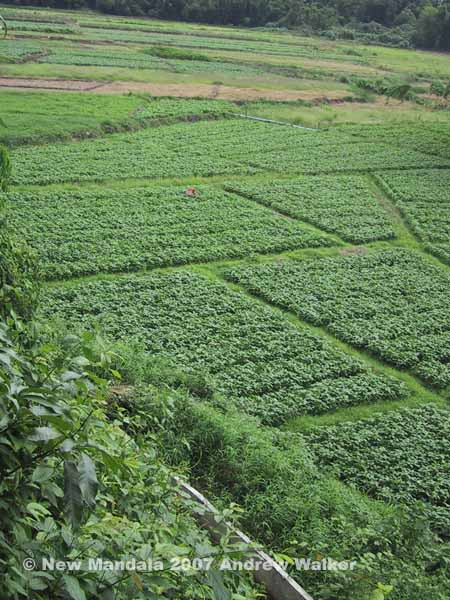Over the past week I have been flat out writing a long overdue paper on the emergence of contract farming in Baan Tiam, the northern Thai village where I have been undertaking research for a number of years. Here is a brief extract from my (very rough!) draft that addresses some of the reasons farmers have taken up this option. It starts out by discussing the problems of debt that have arisen in recent years in relation to garlic production. Garlic is Baan Tiam’s traditional cash crop, but yield and price reductions in recent years have seen a signficant move towards the contract cultivation of alternative crops – tobacco and sweet corn in particular.
The adoption of contract farming in Baan Tiam needs to be understood in terms of the central problem of agricultural debt. A common statement summing up the recent economic dilemma of garlic production is “the more we work the poorer we get” (ying tham ying jon). Garlic is a high cost crop. Part of the reason for this is that new seed stock has to be purchased each year. Farmers consistently claim that using their own garlic production as a source of seed stock results in very low yields. On top of this initial cost, garlic production has increasingly required substantial applications of fertiliser, pesticide and sometimes fungicide. If yields are good these costs are readily covered but declining yields in the early 2000s left many farmers with substantial debts. Of course, garlic production is not the only source of indebtedness but it has been a very significant contributing factor. It is not uncommon for dry season cultivators to report debts of between 50 and 100 thousand baht, with some notable cases reporting debts of 200-300 thousand baht. Baan Tiam’s headman, who had compiled some data on the issue for an official poverty alleviation scheme, told me that there was a total of around 10 million baht of debt within the village (an average of about 80,000 baht per household). In an economy where the average payment for one day’s employment is around 120 baht these debts represent very substantial financial challenges and they are a key source of anxiety, and some resentment.
One farmer eloquently recounted his tale of impoverishment (leaving out the minor detail of the busy rice mill located behind his house). When he first came to Baan Tiam to marry a local woman about 20 years ago he grew garlic and made good profits. Eventually he saved enough to buy a pickup with a “cab.” But his profits started to decline and he sold the large vehicle and bought a more modest standard pickup. But further economic troubles, combined with a rather expensive extra-marital liaison, forced him to sell the pickup and now he is reliant on a motor-bike. And, he added, so many villagers are in debt that a system of rotating debt (nii mul wian) had developed whereby farmers borrow from the agricultural cooperative to pay the bank and borrow from the bank to pay the cooperative, and borrow from local money lenders to pay both.
The primary attractiveness of contract farming for these farmers is that they don’t have to pay the crop’s input costs. Farmers regularly state that they have become interested in contract farming because they do not have to invest their own capital (which is usually borrowed): “we are growing for the companies because at least they are willing to invest the capital, we don’t have to hurt ourselves with debt, we don’t have to get stressed or tired. Investing labour is not as stressful as investing money.” Almost all the contracting companies provide the farmers with seedlings (or seed) and agro-chemicals. The cost of these inputs is then deducted from the selling price of the crop. If the crop fails the loss is borne by the company. Of course crop failure is still regarded as something of a disaster, but farmers regularly state that their only loss is the time they have invested in the crop and that their debt situation is not worsened. Farmers also acknowledge, not without some resentment, that the input prices charged by the company are often somewhat higher than market rates but the fact that the company is bearing the risk of investment is generally regarded as outweighing this disadvantage. One farmer, Jakrit, summed up the common view of the benefit of contract farming:
The companies have been coming for a long time but people were not interested because people just wanted to grow garlic. People only really became interested in the past few years. The first person to grow peas for a company was the headman. The first year, he grew 15 rai and made about 200,000 baht. The second year he could not rent so much so grew a lot less. This year I tried out less than one rai and I made 6000 baht from just that little bit. The company is good, the inputs just arrive – seeds, fertiliser and chemicals. If it is not Saturday or Sunday you can just ring up the broker and the fertiliser and chemicals just come. And the extension officers come and check on what we are doing and give us advice if we need to change anything. And if the crop fails there is no cost and no problem. The company does not want us to invest our own money because they are afraid we will sell to other companies. There are several of them that would want to buy. Modern Foods has a quota of about 500 rai for the whole district. So why not grow for them? If you grow your own crops you have to go and borrow from the cooperative and if the crop fails you are in debt and the interest just mounts up and up (dok, dok, dok, dok, dok, dok). And you get more and more into dept. But there is no problem with the company. All you lose if it fails is your labour.
 Facebook
Facebook  Twitter
Twitter  Soundcloud
Soundcloud  Youtube
Youtube  Rss
Rss 